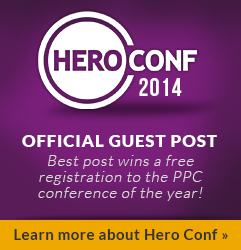Editor’s Note: This article is a part of our Hero Conf guest post contest. Based on a combination of pageviews and editorial review from the PPC Hero writing staff, a winner will be chosen from the finalists we post throughout the week. Today’s post comes to us from Justin Seibert (@domjbs), President of Direct Online Marketing.
 Selling products into a new country can seem like a daunting task – especially for first-time exporters. Some great tools – like the U.S. Commercial Service’s Gold Key program – exist, but sometimes you just want to see if a particular country is worth pursuing before you invest even mid-level amounts of time and money. Enter you bosom buddy, Google AdWords. It’s like you’re Tom Hanks and AdWords is the other guy.
Selling products into a new country can seem like a daunting task – especially for first-time exporters. Some great tools – like the U.S. Commercial Service’s Gold Key program – exist, but sometimes you just want to see if a particular country is worth pursuing before you invest even mid-level amounts of time and money. Enter you bosom buddy, Google AdWords. It’s like you’re Tom Hanks and AdWords is the other guy.
A Note about PPC Market Share
AdWords is the number one paid search ad provider in all but the following countries (leading platform in parentheses):
- China (Baidu)
- Russia (Yandex)
- Korea (Naver)
- Japan (Yahoo!* Search Marketing – yes, they still exist as Yahoo!. Japan’s corporate ownership is different than regular ol’ Yahoo!)
- Taiwan (Bing Ads served on Yahoo! after Microsoft finally won its lawsuit with their “partner”)
- Honorable mention to the Czech Republic, where AdWords is #1, but Seznam has a large share.
* Oh, I’ll use the exclamation point with their name alright.
With most of the above, you can still get some penetration with AdWords either through Google’s local search engine or its partnerships, but it may not give you a true test of relevant audiences. And if you want to be in China, you flat out have to use Baidu. Remember, Google left there due to concerns about servers being hacked and how they could operate profitably its Don’t Be Evil policy.
Given their global market share and the comfort level most US advertisers have with the AdWords platform, let’s focus on it here.
Ecommerce
If you’re selling on your website already, wunderbar, supertoll. That will make it quicker to measure feasibility. And that’s easier than ever to test new markets given Google’s release of Shopping campaigns to all advertisers in all countries. Shopping campaigns are replacing Product Listing Ad campaigns, which are getting phased out and only available in about two dozen countries. So get cracking; just be aware of the following:
- Shipping options. These can vary wildly – check out all carriers. And if you get serious with overseas, be sure to negotiate for better rates.
- US export regulations. Depending on what you’re selling, this can be a quagmire, so it’s best to reach out to your friendly neighborhood Commercial Service Officer. Pro Tip: don’t try selling centrifuges into Iran. They have stings for that.
- Customs and general issues in other countries. One client recently told me his four most difficult countries are Russia (general difficulties, FedEx and DHL refusing to ship orders over a certain dollar amount or altogether to individuals, and discussions of a 30% tax increase on imports over $200), Venezuela & Argentina (currency control issues), and Brazil (100% duties on some products).
Also consider using Amazon for foreign sales. Their merchant fees are much higher than traditional merchants, but they guarantee you get paid on any order they clear and you ship. That can let you breathe a little easier on your first shipment to Nigeria.
And if you want to sell online, but not go through the hassle of creating ecommerce functionality on your own site, you can use an online marketplace like Alibaba or Mercado Libre.
Lead Generation
If you’re selling higher ticket items or just want to sell in higher volume, you may instead want to test a lead gen campaign in your target market. Here you’re trying to make contacts and start building relationships to establish trust. In many countries, it’s extremely difficult to make sales without in person contact, so this allows you to build up a list of contacts to make a trip more worthwhile. Plus it gives you a chance to tack on a day or two for vacation since airfare is already covered by work.

Insert your own monkey joke here.
While I’ve separated out lead generation from ecommerce, many exporters end up doing a blend of both efforts. Ecommerce is used for onesie-twosies as well as test orders, while the advertiser establishes new leads for further engagement.
Final Thoughts
Follow all the best practices you would for foreign campaigns and paid search in general. These include:
- Match language on ads and landing pages. It can be okay to run English ads in countries where it’s not the primary language – just be sure if you do, the landing page matches.
- Professional translation is always better, but sometimes for a quick test, Google Translate will work. Especially for locally hard to find, niche products where people can see pictures and SKUs.
- Work extra hard on credibility signals. Remember that people need to put a lot of faith that they won’t get screwed by some company they’ve never heard of who’s a half a world away.
Good luck in all your tests and best wishes for expanding your or your clients’ sales.




